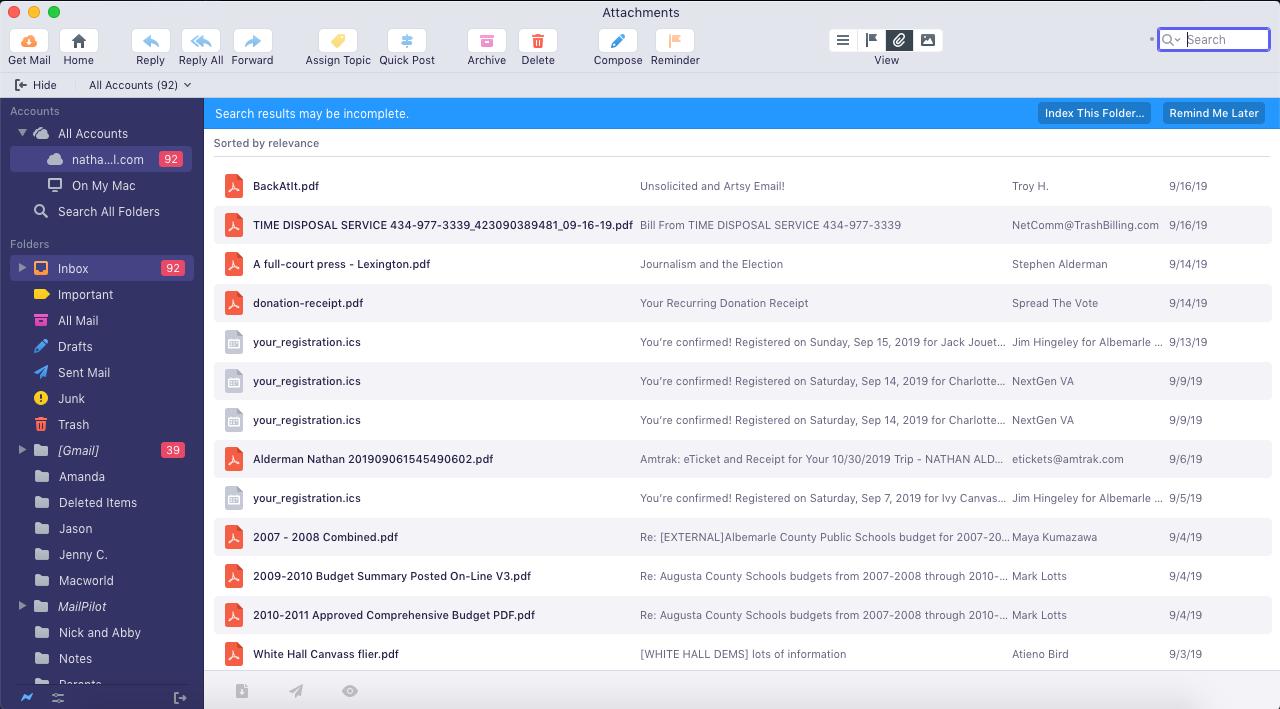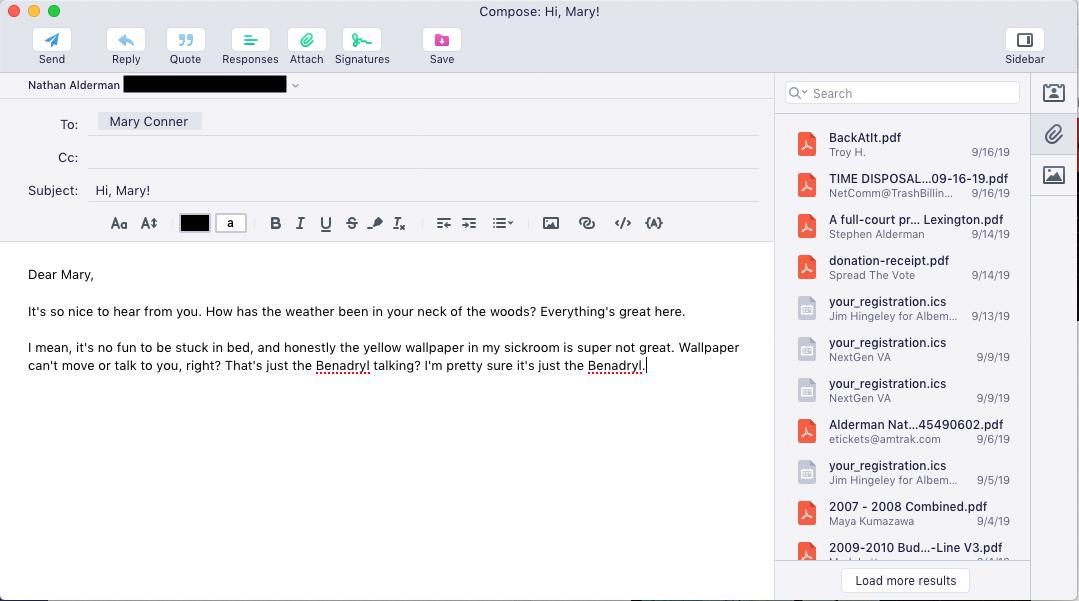I liked Postbox's previous versions when I reviewed them for other sites. But over the years, I drifted away from Postbox, Inc.'s eponymous pride and joy, and every other dedicated email app, in favor of just checking Gmail on the web. I spent so much time in my browser anyway that firing up another app to check or send messages seemed pointlessly time-consuming. Yet the brand new Postbox 7 has succeeded in turning my head.
The last version I tried layered impressive features atop the increasingly creaky underpinnings of Mozilla Thunderbird; Postbox 7, while still based on Mozilla code, has a far sturdier – and faster – foundation. The previous version looked stodgy, square, and gray; the new one blooms with 20 eye-pleasing themes. Add that to a frankly ridiculous level of useful abilities, and you've got an app that makes a solid case for keeping one less tab open in your browser.
The email client you never knew you wanted
Postbox is best described as "Apple Mail but with literally every feature you ever wished Apple Mail had, plus some other features, plus more features on top of those."
Sure, it does all the usual email-y things, quickly and well and in a nice-looking interface. It supports both IMAP and the increasingly rare, old-school POP mail. Colorful, well-labeled icons prevent confusion, message and thread headers come with handy previews and message counts to track data, and messages with inline photos and other formatting display beautifully. The aforementioned themes offer a lovely mix of colors and styles, both in light and dark mode, to suit any preference and personality.

Setup's a snap, too, whether you're starting fresh or importing settings from a previous version. I dreaded having to slog over to Gmail and create yet another app password, but nope! Postbox not only configured all its settings correctly based solely on my email address but also helpfully opened a window to Gmail to walk me through its end of the setup process automatically. And once that was finished, a flotilla of useful, coherent tutorial videos popped up for my edification.
The programmers' promise that Postbox 7 is three times as fast as its predecessor holds up, too. On an aging laptop or a modern iMac, the app felt fast and responsive – at least once it finished indexing all 2,000 of my downloaded messages. That process was understandably poky, but not agonizingly so. As with previous versions, Postbox's help files proved clear, concise, and easy to follow – which is good, because as you'll soon see, you'll probably want to consult them more than once.
iMore offers spot-on advice and guidance from our team of experts, with decades of Apple device experience to lean on. Learn more with iMore!
In short, you can rest assured that Postbox 7 covers the basics well. But the more you venture off the beaten path of forwards and replies, the more you begin to see what Postbox can really do.
Calling all power users
Every client will show you messages, of course, and plenty also let you narrow those messages down to just the ones you've flagged as reminders. But Postbox also lets you view your messages by attachments or photos, and each view (once indexed) is fully searchable. You don't need to go trawling through piles of messages in search of that one adorable picture of your nephew when it's right there at your fingertips.

A similar helpful sidebar pops up in the Compose window, putting both attachments and images already in your inbox right at your fingertips, should you wish to send them along to friends. The Compose sidebar also adds a handy address book that instantly pulls in all your macOS Contacts. But if a separate Compose window's just too much to bother with, you can also compose a quick reply to any message right from the main message-viewing window.
But that's just the start of what Postbox can do. (This is where those aforementioned help files start coming in handy.) If you're juggling multiple accounts, you can set up "domain fencing" to ensure that you never accidentally send a personal email from a work account, or vice versa. Once properly warned, Postbox will flag any addresses that don't seem to match the domain you're sending from. (One would think any number of politicians might clamor for that particular feature.)
If you find yourself copying and pasting the same form email messages over and over and over, Postbox can save you the hassle. Its built-in responses feature lets you create as many different premade messages as you want, right at your fingertips in the compose window. (You can even name them so that they appear in custom-made nested categories within the Responses menu.) Its Placeholder feature uses simple snippets of code to mark places in those responses where Postbox can either automatically pull in data like the recipient's name or address, or just let you easily hopscotch through the message filling in those blanks yourself. And if you're pressed for time or just a particularly bad speller, Postbox even offers its own extensive library of professionally written responses for your use.

But wait, there's more! Postbox 7, not content to offer full HMTL editing of any message, also offers Clips — easily insertable chunks of custom HTML, including CSS styling, that you can add to any message. You can use its existing library of attractive-looking elements like captioned image blocks, pull quotes, bullets, and more to create beautiful email newsletters with ease or create your own custom clips alongside them.
And in addition to built-in support for Evernote and several other popular productivity apps, Postbox's Quick Post feature works with services like IFTTT and Zapier, and through them with apps like Trello and Slack, to quickly add service-friendly tags to an email and fire it off to those services for easy integration.
Postbox 7 has ditched its predecessor's Thunderbird-based add-ons but replaced them with Postbox Labs, a home for experimental (and largely unsupported) extensions and additions to the program's capabilities. At launch, the rather modest selection includes the ability to encrypt your mail through OpenPGP.
Before you lunge for your wallet…
Obviously, I liked Postbox 7 a lot – but that doesn't mean it's perfect. I ran into annoying but non-dealbreaker hiccups during my test of the program. One email address, copied from Microsoft Outlook, pasted in strangely, and repeated attempts to edit it couldn't manage to fix it. Another time, a fresh install of the app wouldn't index my messages until I quit the program and reopened it.
Postbox 7 is also way, way, way more email client than most human beings will ever need. Unless you rely heavily on email in your professional life or really dig all of Postbox's integrations with other productivity tools, you can probably get by with Apple Mail or your web-based mail of choice. That's especially true since Postbox 7 has switched to the dreaded subscription-based app model. If you want to enjoy its considerable splendor, expect to pay $30 every year for the privilege.
My verdict
If you live and die by email, that $30 could be money well spent. Postbox runs like a champ, looks like a dream, works like a different and mostly good but very occasionally weird and confusing dream, and has more cool tricks stuffed into it than one of those high-end Swiss Army knives the approximate thickness of a paperback book. You might not need an email client this great, but if you do, you likely won't find a better one.

Nathan Alderman is an iMore contributor. He’s been using Apple computers since his first Apple IIe in 1985, and writing professionally about Macs and their software since 2005. During his 12 years freelancing for Macworld, he covered email clients, web browsers, web design programs, writing apps, and games, and he’s continued to follow those interests at iMore since 2017. An editor and writing coach in his full-time career, he spends his dwindling spare time writing fiction for fun, volunteering for democracy, and contributing to podcasts on The Incomparable Network. Nathan adores his wife and wrangles his alarmingly large children in bucolic Crozet, VA.

